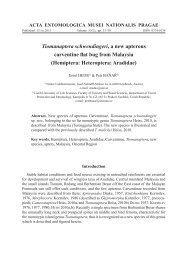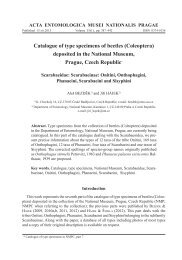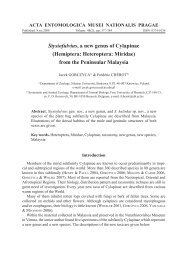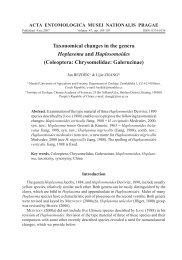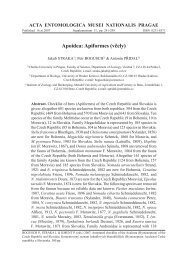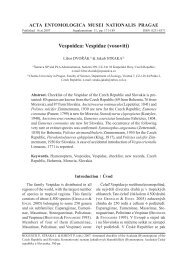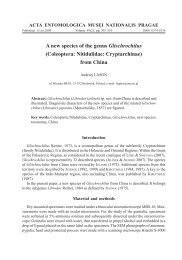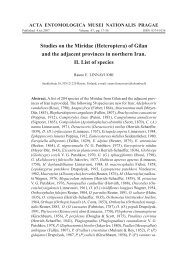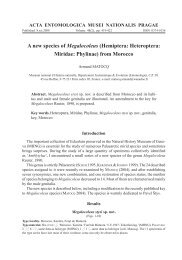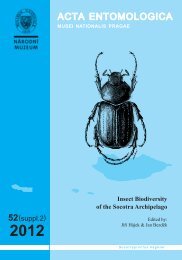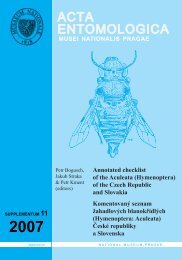Revision of the Palaearctic species of the Coccinella ...
Revision of the Palaearctic species of the Coccinella ...
Revision of the Palaearctic species of the Coccinella ...
Create successful ePaper yourself
Turn your PDF publications into a flip-book with our unique Google optimized e-Paper software.
156<br />
KOVÁŘ: <strong>Coccinella</strong> transversoguttata <strong>species</strong> group and notes on o<strong>the</strong>r <strong>Coccinella</strong><br />
variable and/or specimens with isolated elytral spots may to a various degree dominate in <strong>the</strong><br />
local populations. FILIPPOV (1961) surveyed <strong>the</strong> variability <strong>of</strong> <strong>the</strong> elytral colour pattern and<br />
recorded numerous colour deviations. Although he illustrated some cases <strong>of</strong> longitudinal connection<br />
betwen two spots, <strong>the</strong> <strong>species</strong> never has <strong>the</strong> tricuspidate pattern <strong>of</strong> C. marussii or C.<br />
hodeki sp. nov.<br />
Distribution. The nominotypical sub<strong>species</strong> occurs in China (Gansu, Quinghai, Shaanxi, Sichuan,<br />
Xinjiang, Xizang and Yunnan provinces), Kazakhstan, Kyrgyzstan, Mongolia (widely<br />
distributed in all provinces), Nepal (Pokhara province), Russia (West and East Sibiria: Irkutsk,<br />
Tomsk, Tuva, Yenisseisk, Yakutia; Far East: Amur province, Khabarovsk district, Primorskiy<br />
district, Magadan region, Kamchatka, Sakhalin). Older records from nor<strong>the</strong>rn Scandinavia<br />
and <strong>the</strong> nor<strong>the</strong>rnmost territory <strong>of</strong> European Russia were not confirmed (BROWN 1962).<br />
Discussion. <strong>Coccinella</strong> transversoguttata <strong>species</strong> group is related to <strong>species</strong> belonging to C.<br />
novemnotata and C. difficilis <strong>species</strong> groups proposed by DOBRZHANSKIY (1931), all having<br />
<strong>the</strong> median lobe <strong>of</strong> aedeagus divided into two portions. However, <strong>the</strong> distal portion is differently<br />
shaped in C. transversoguttata group. <strong>Palaearctic</strong> <strong>species</strong> <strong>of</strong> <strong>the</strong> group may be identified<br />
by <strong>the</strong> key given below.<br />
<strong>Coccinella</strong> transversoguttata was originally described by FALDERMANN (1835) from Irkutsk<br />
(type depository unknown). The concept <strong>of</strong> <strong>the</strong> <strong>species</strong>, broadly distributed in <strong>the</strong> Holarctic<br />
region, was soon uncritically widened. Three taxa with a characteristic subbasal transverse<br />
band on <strong>the</strong> elytra were described before 1850: C. transversoguttata; C. ephippiata Zetterstedt,<br />
1837 from Greenland and C. quinquenotata Kirby, 1838 from <strong>the</strong> Nearctic region.<br />
MULSANT (1850a) synonymized C. quinquenotata toge<strong>the</strong>r with C. ephippiata as a variety<br />
(‘Var. A.’) <strong>of</strong> C. transversoguttata (‘Var. B.’), and described a similar <strong>species</strong>, C. transversalis<br />
Mulsant, 1850, from Mexico. He subsequently replaced <strong>the</strong> preoccupied name C. transversalis<br />
Mulsant (nec Fabricius, 1781) with C. nugatoria Mulsant, 1850 (MULSANT 1850b).<br />
CROTCH (1874) listed all <strong>the</strong>se taxa under C. transversoguttata and added a new synonym, C.<br />
californica Mannerheim, 1843, as an extremely pale variety. WEISE (1879, 1885, 1892) regarded<br />
all taxa as identical and separated only quinquenotata as a variety. Later, all taxa<br />
synonymized with C. transversoguttata were downgraded by MADER (1930 in 1926-1937) to<br />
mere aberrations, who described additional four. Dobrzhanskiy provided a short key <strong>of</strong> female<br />
genitalia (DOBRZHANSKIY 1924), illustrated <strong>the</strong> aedeagus <strong>of</strong> a <strong>Palaearctic</strong> specimen (DO-<br />
BRZHANSKIY 1926) and male and female genitalia <strong>of</strong> Nearctic representatives (DOBRZHANSKIY<br />
1931), as well as separated C. californica from C. transversoguttata (DOBRZHANSKIY 1931).<br />
Somewhat unfortunately, he also divided <strong>the</strong> latter <strong>species</strong> into two partly sympatric sub<strong>species</strong>,<br />
C. t. transversoguttata and C. t. nugatoria. BROWN (1962) treated <strong>the</strong> infraspecific variability<br />
<strong>of</strong> Nearctic populations <strong>of</strong> C. transversoguttata, originally named as C. quinquenotata<br />
Kirby, 1837 (not C. septempunctata var. quinquenotata Haworth, 1912). He replaced that<br />
name with C. richardsoni Brown, 1962 and delimited two sub<strong>species</strong>, C. t. richardsoni and<br />
C. t. ephippiata. He also considered Mexican populations as specifically distinct and used <strong>the</strong><br />
names C. nugatoria nugatoria and C. nugatoria sonorica for <strong>the</strong>m (BROWN 1962, 1967). LIU<br />
(1962) described C. geminopunctata from China. The type series was composed <strong>of</strong> 10 selected<br />
specimens <strong>of</strong> both sexes from Gansu, Xinjiang and Yunnan provinces. The specimens had<br />
elytra with black spots normally developed but isolated, and <strong>the</strong> schematic illustrations <strong>of</strong>



